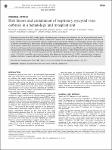Risk factors and containment of respiratory syncytial virus outbreak in a hematology and transplant unit
Lehners, N.
Schnitzler, P.
Geis, S.
Puthenparambil, J.
Benz, M. A.
Alber, B.
Luft, T.
Dreger, P.
Eisenbach, C.
Kunz, C.
Benner, A.
Buchholz, Udo
Aichinger, E.
Frank, U.
Heeg, K.
Ho, A. D.
Egerer, G.
Respiratory syncytial virus (RSV) usually causes self-limiting upper respiratory tract infections, but can be associated with severe lower respiratory tract infection disease (LRTID) in infants and in patients with hematologic malignancies. We have analyzed the risk factors and the measures for containment within an outbreak of nosocomial RSV infections in a hematology and SCT unit. A total of 56 patients were affected (53 RSV-A and 3 RSV-B) including 32 transplant patients (16 allogeneic and 16 autologous). Forty (71%) of the 56 patients suffered from LRTID and 14 (35%) of the patients with LRTID subsequently died. However, because of concomitant infections with fungal and bacterial pathogens, the impact of RSV on the fatal outcome was difficult to assess. Multivariate analysis showed that low levels of IgG were significantly associated with fatal outcome (P=0.007), treatment with oral ribavirin represented a protective factor (P=0.02). An extremely protracted viral shedding was observed in this cohort of patients (median=30.5 days, range: 1–162 days), especially pronounced in patients after allogeneic transplantation (P=0.002). Implementation of rigorous isolation and barrier measures, although challenged by long-term viral carriers, was effective in containment of the outbreak.
No license information

